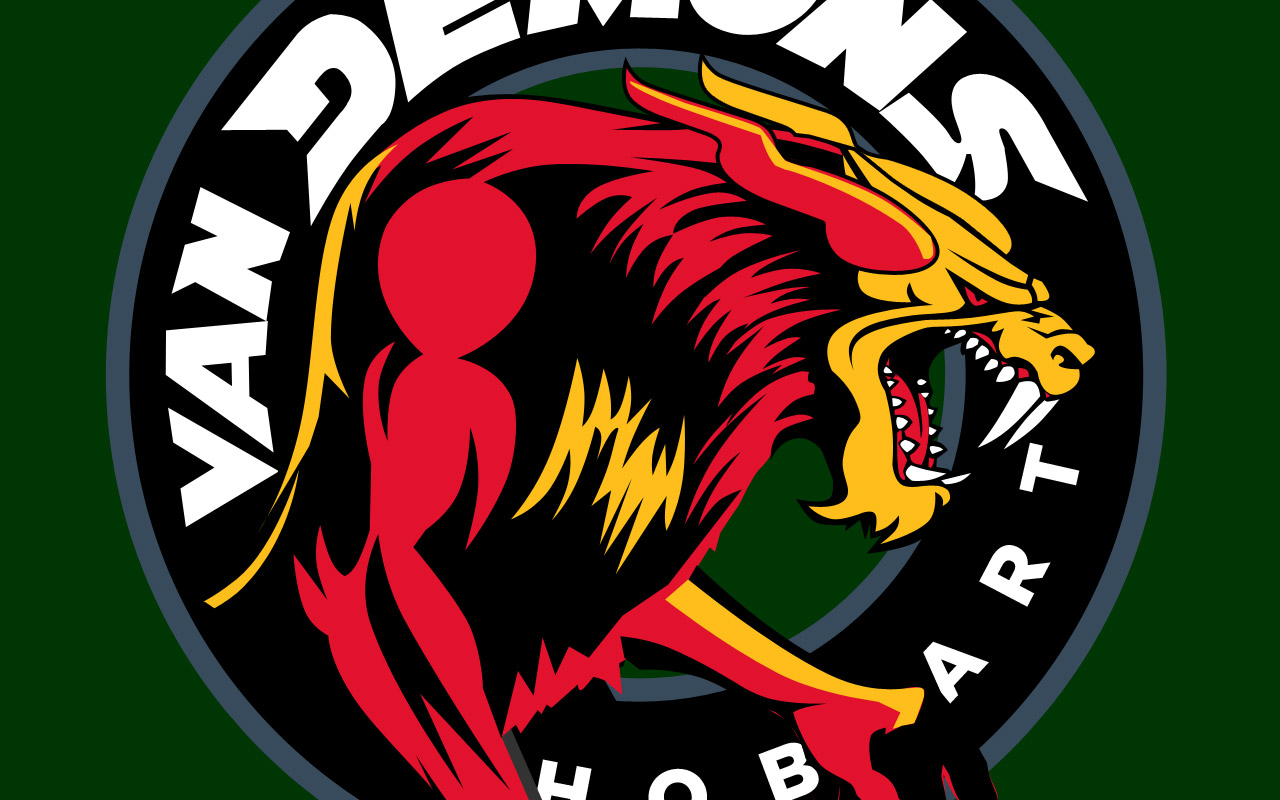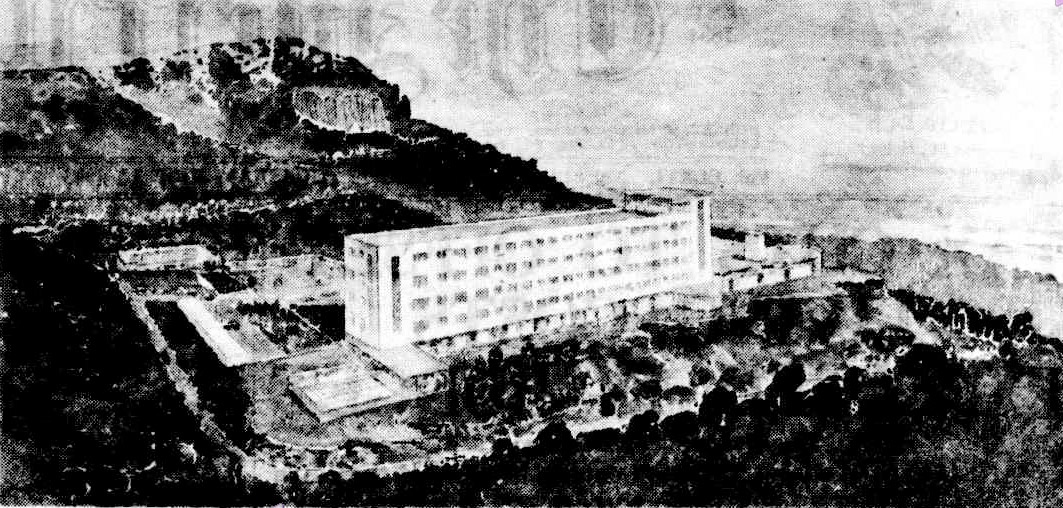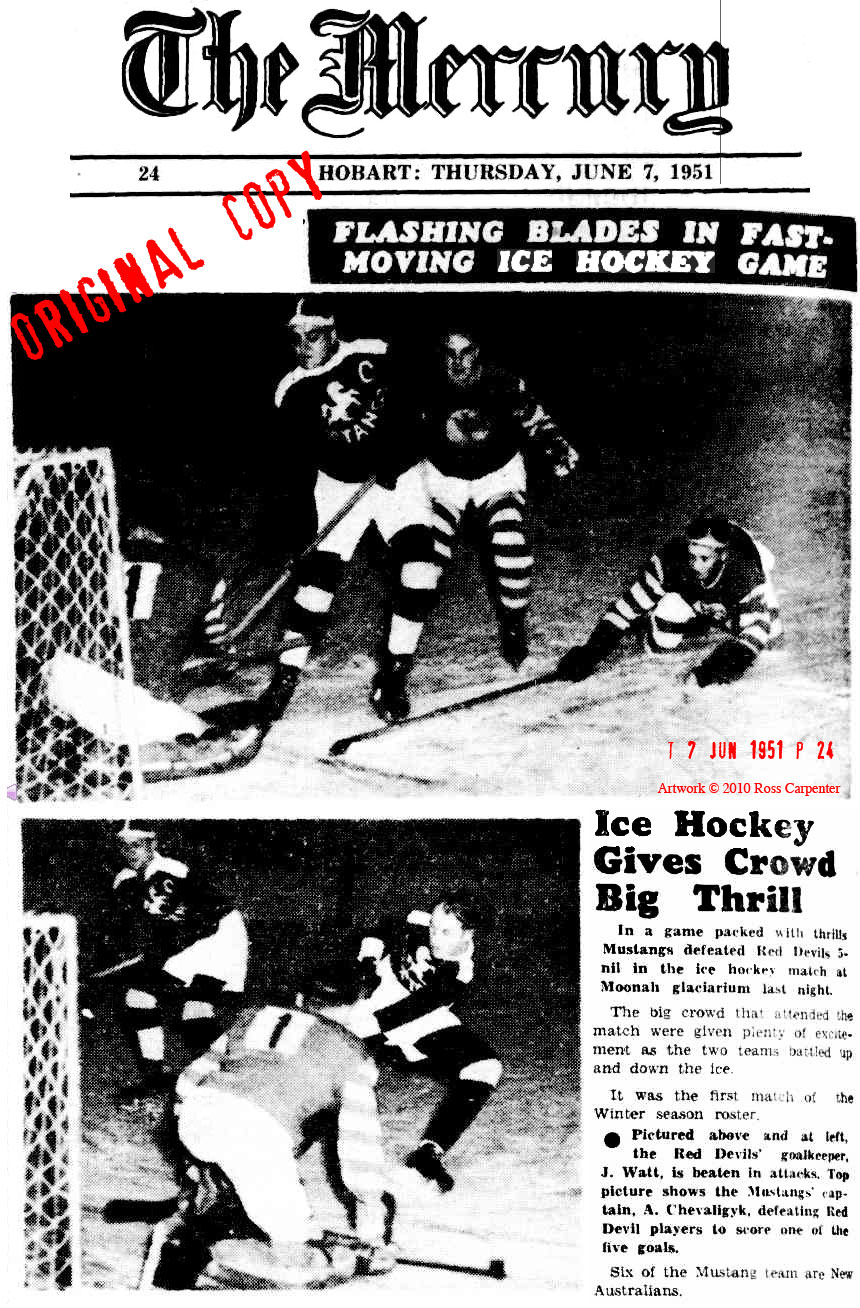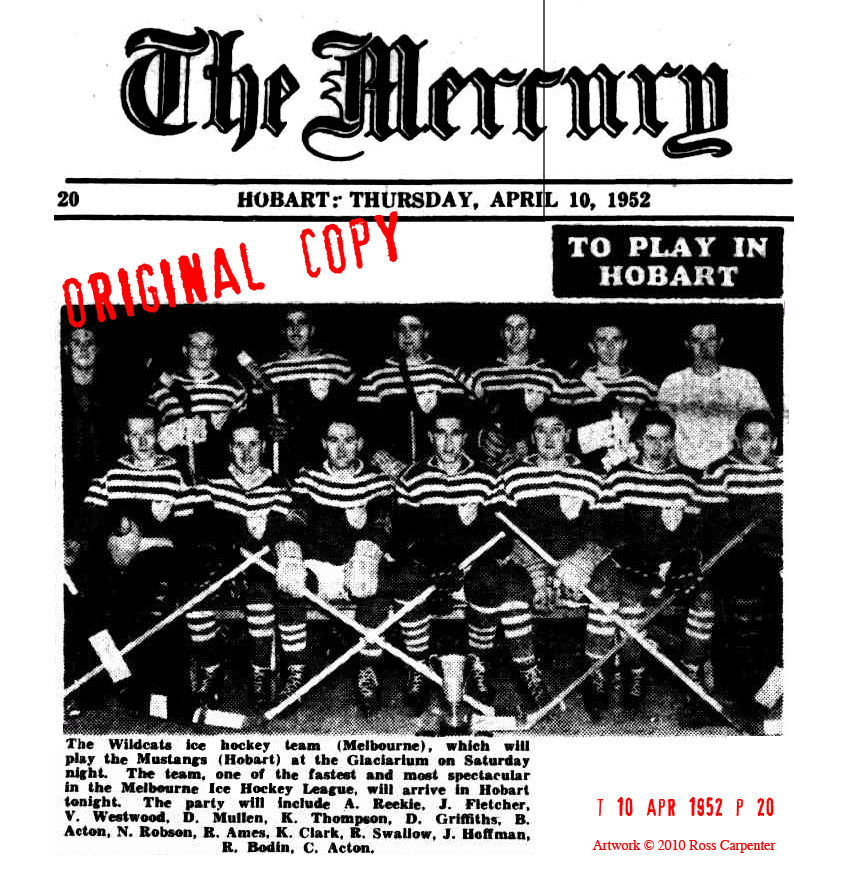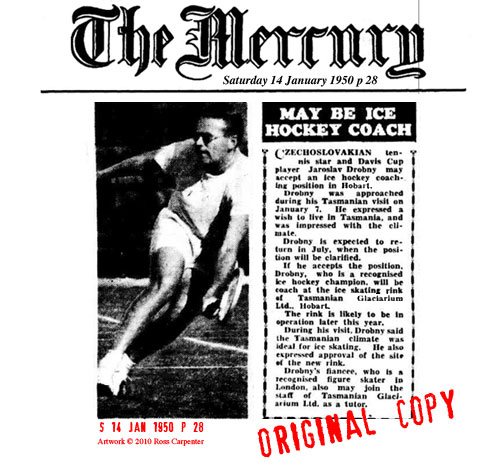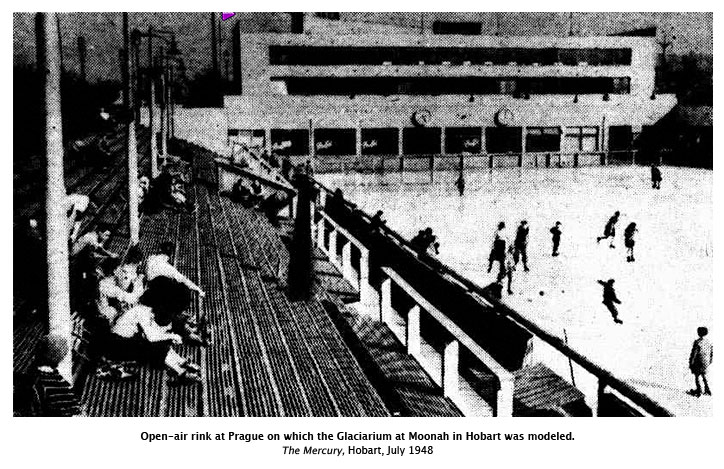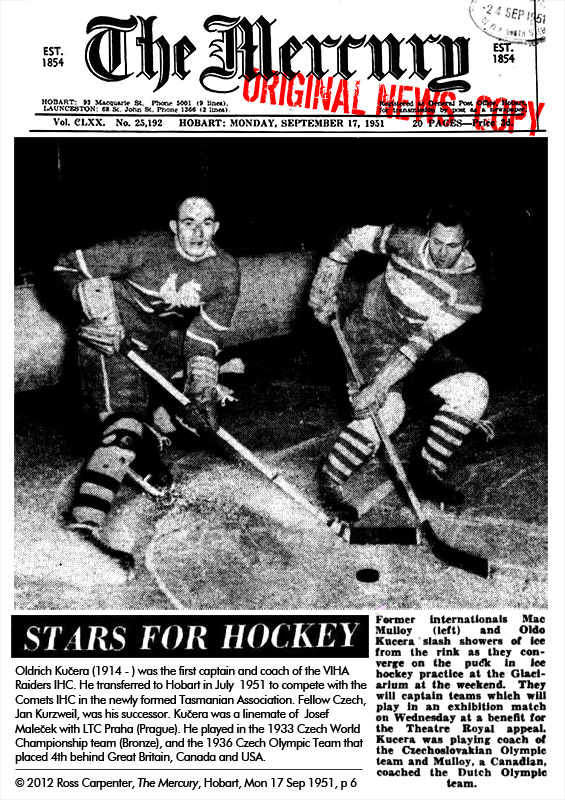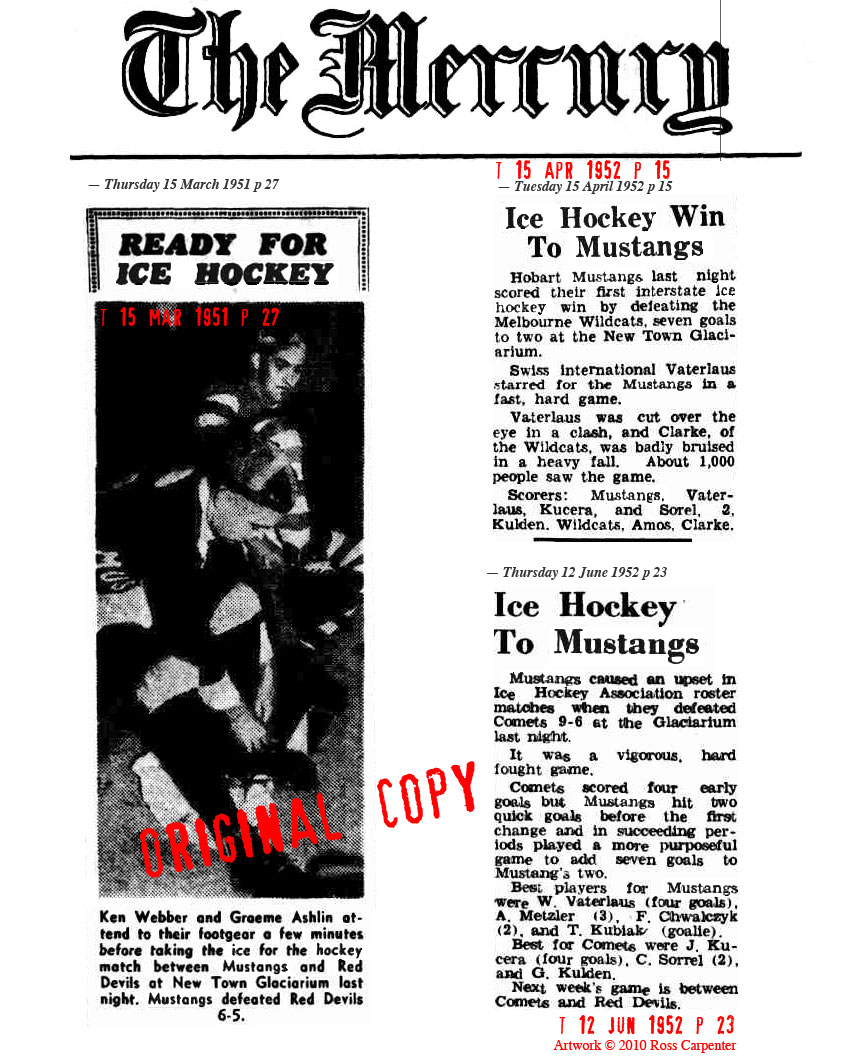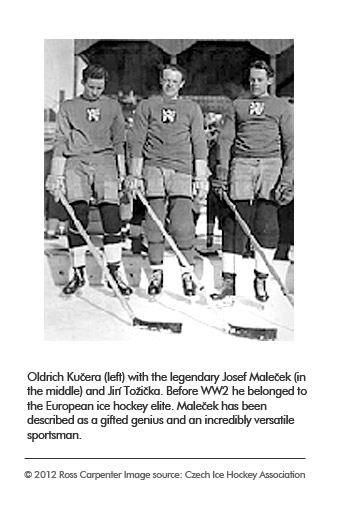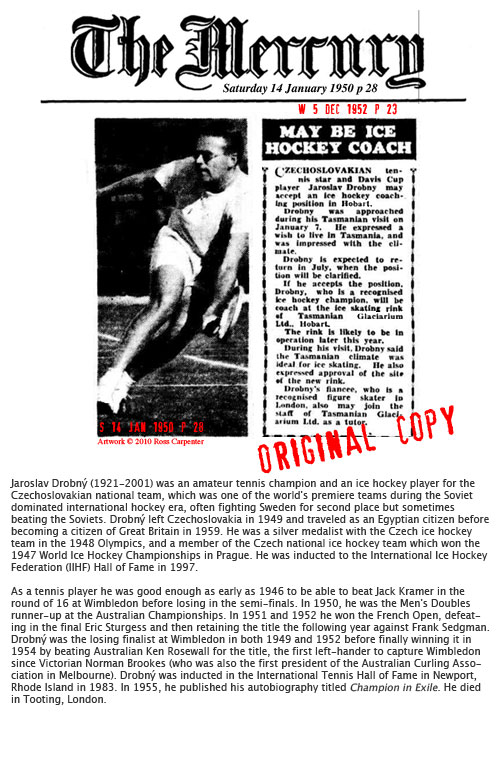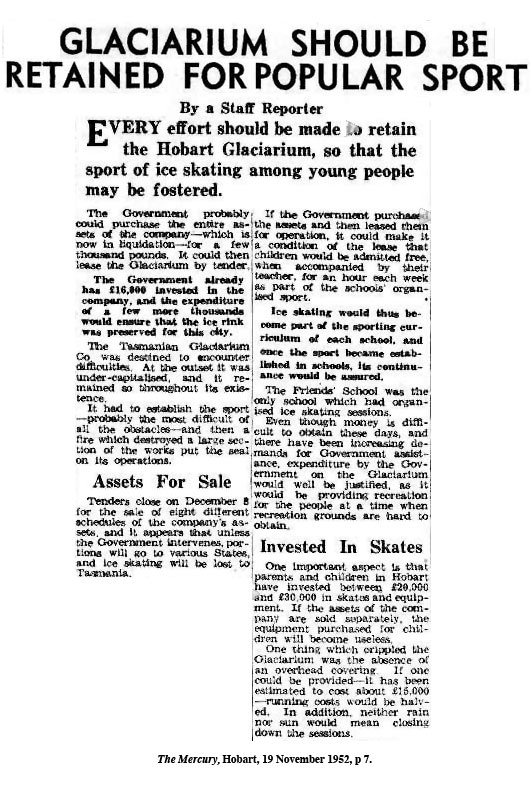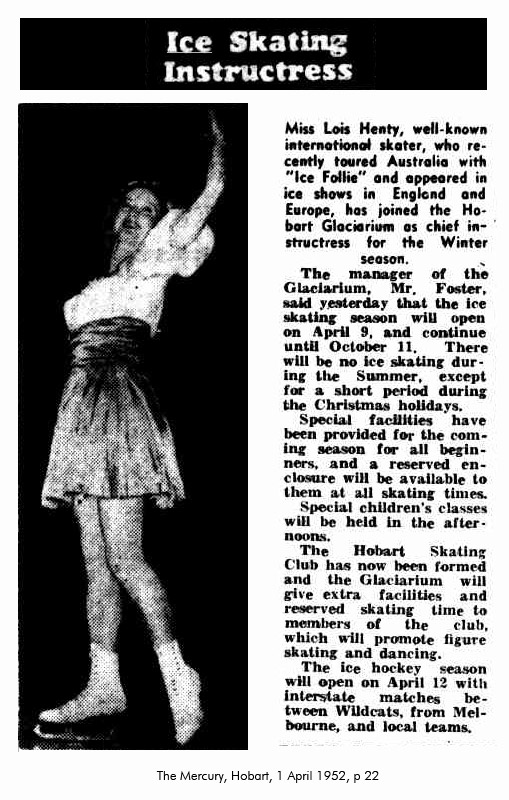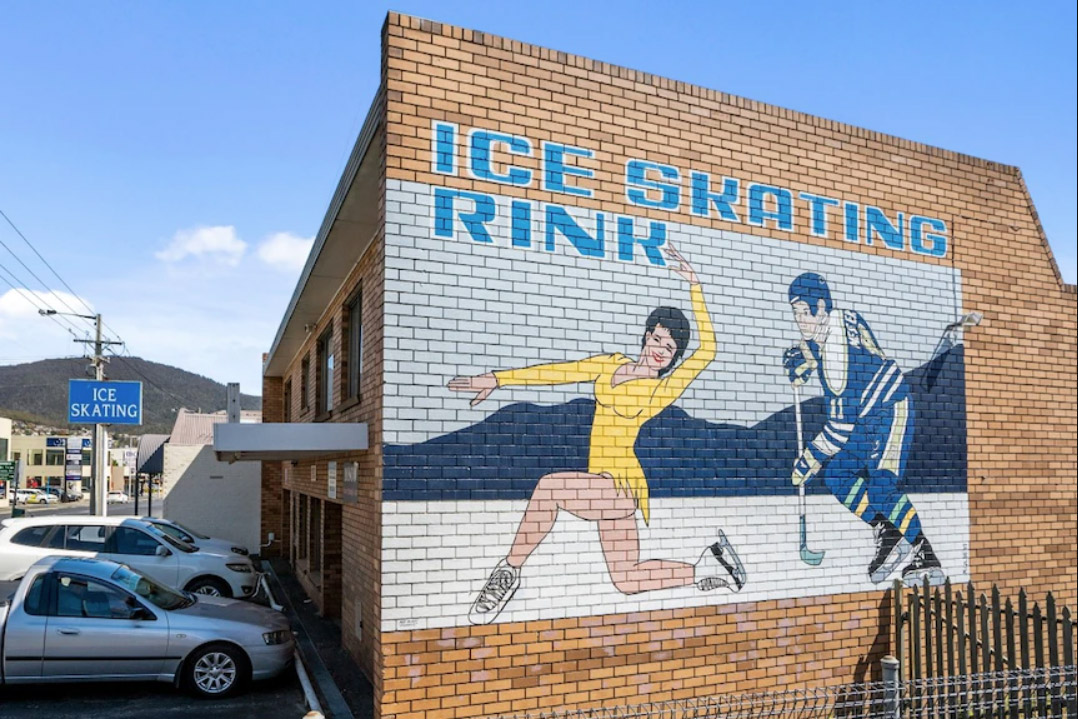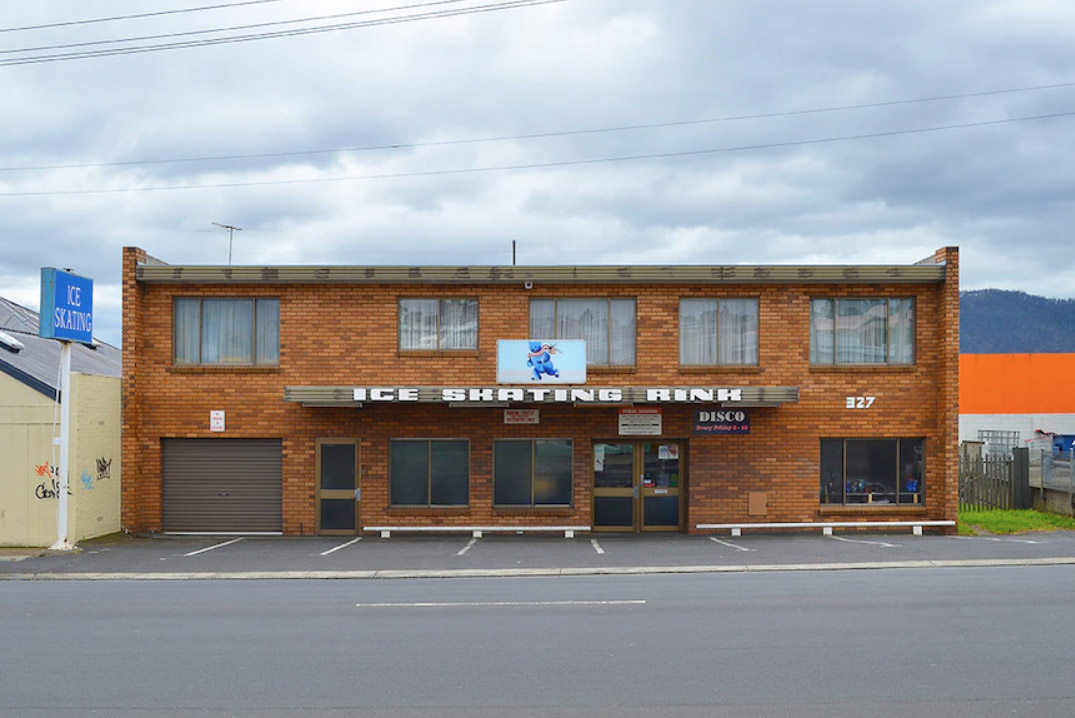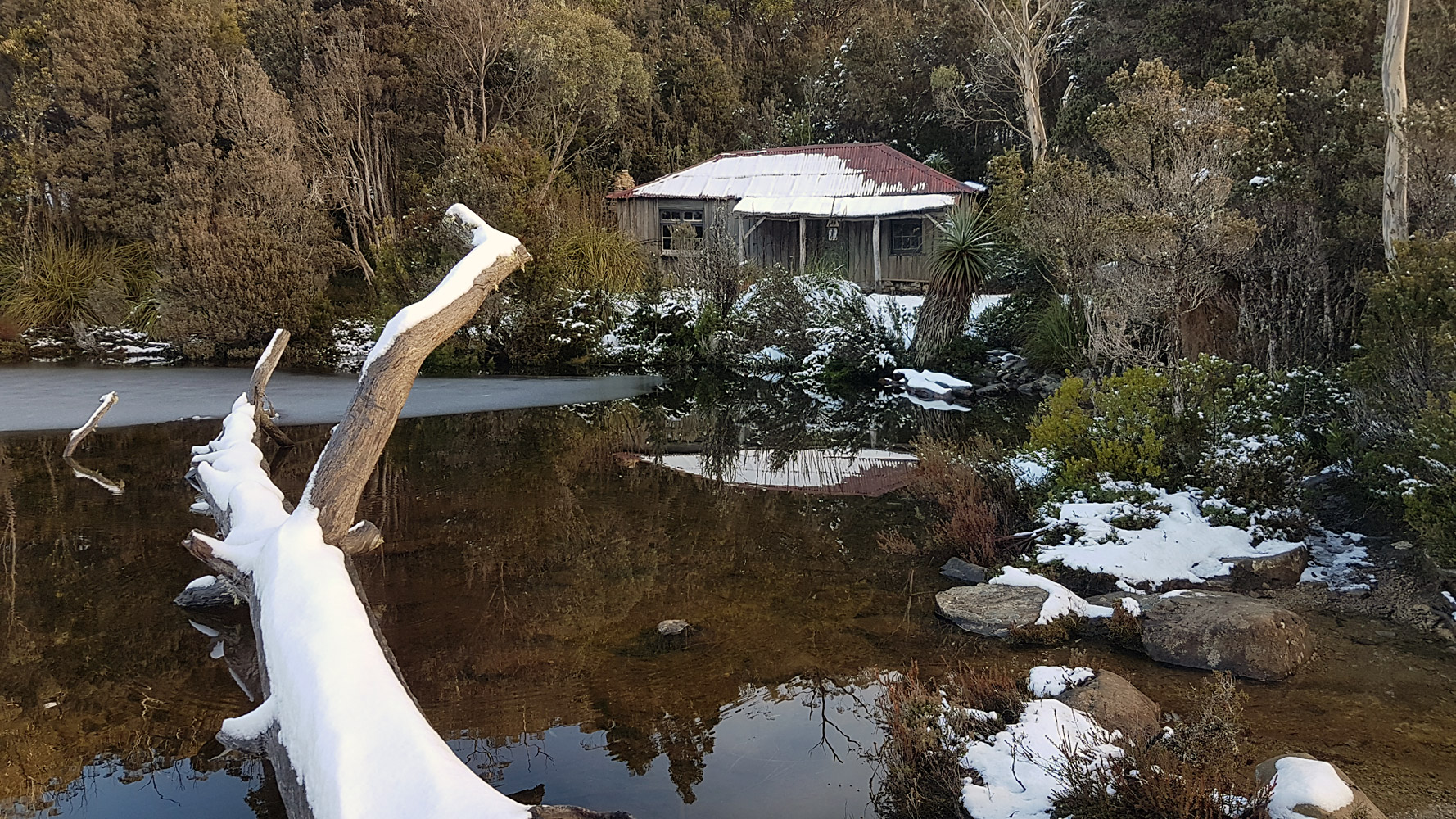
The ski hut at Twilight Tarn, a short walk from Tarn Shelf where ice skating began in Tasmania.
Van Demons Land
W D Counsell and the Twilight Tarn
 As senior ice hockey referee the closing of the rink was a blow to me, because I know the big interest shown by young men in the sport. In a little more than a year Hobart built up an ice hockey team which was equal to a Victorian representative side. Despite their loss in the fire at the rink many young men were willing to keep the sport going.
As senior ice hockey referee the closing of the rink was a blow to me, because I know the big interest shown by young men in the sport. In a little more than a year Hobart built up an ice hockey team which was equal to a Victorian representative side. Despite their loss in the fire at the rink many young men were willing to keep the sport going.
— Reg R Wilson, ice hockey referee, The Mercury newspaper, Hobart, 1952 [1]
There are many disappointed and disillusioned young people who have had a sport and relaxation taken away without reasonable explanation. Surely something could be done to restore the rink. Visiting clubs from other States were unanimous in praise of the rink, and the people of Hobart should act to prevent the loss of the Glaciarium.
— Speed Skater,The Mercury newspaper, Hobart, 1952 [1]
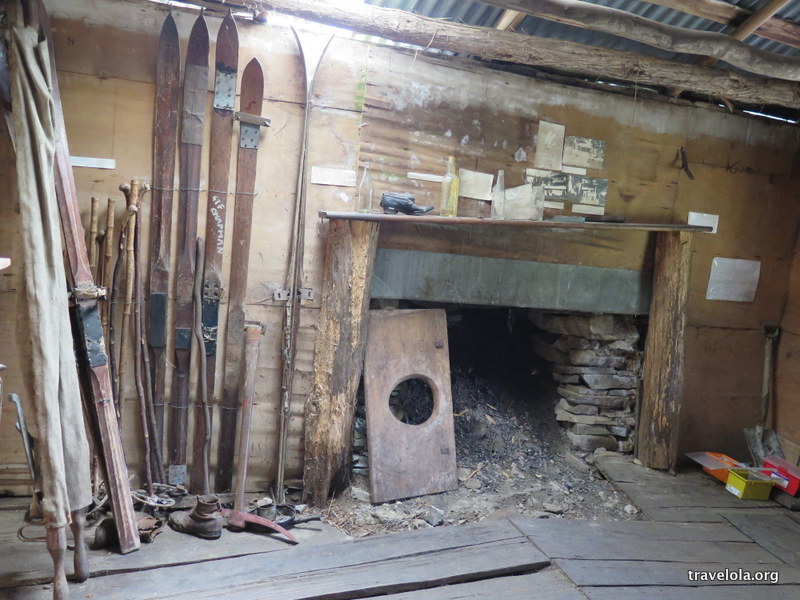 Inside the 1920s ski hut at Twilight Tarn.
Inside the 1920s ski hut at Twilight Tarn.
THE STORY OF ICE SPORTS in Tasmania has its roots in the Mount Field National Park during the 1920s. Dr W D Counsell and his sister Florence were members of the Tasmanian Ski Club and often stayed at the Club's hut at Twilight Tarn to ski Mt Field West. Nine miles by horseback from the Park entrance, club members built it in 1927 and used it regularly until the late 1950s. Once there, skiers walked up the hill behind Lake Newdegate to the wide-open bowl above and skated on Tarn Shelf, the ancient glacial landform in front.
Counsell set up the Ice Skating Club of Tasmania with the founding president, Dr Stuart Gibson, on 25 March 1938. The honorary ophthalmologist at Hobart General Hospital was the club's founding secretary. Gibson was president of the Tasmanian Council of the British Medical Association. During these years, Counsell investigated blindness in Tasmania with John Bruce Hamilton, the grandson of parliamentarian, company director and merchant John Hamilton. The Royal London Ophthalmic Hospital awarded them their Gifford Edmunds prize.
Skaters had wanted a club or association for some time, a "definite body" to approach the government to develop a natural skating pond at the pinnacle of Mt Wellington in Hobart. Tasmania had roller rinks but never an ice skating rink, and this was just one of several development ideas talked about for years.
In May 1939, Hobart City Council decided to lay down an experimental ice floor which they completed in July. A small test area of ice six inches thick demonstrated it would be strong enough for skating. Nothing happened until October 1940, when a proposal surfaced to construct a "glaciarium" at Hobart City Hall as a way "for the City Council to reduce the annual loss incurred on the building". Again, nothing happened. A whole decade went by until a Sydney developer proposed a 150-room hotel with an ice rink at The Springs on Mount Wellington in 1948. It, too, fizzled.
Earlier that year, a new company called The Tasmanian Glaciarium Pty Ltd placed a proposal before Council for Australia's first open-air ice rink. Estimated to cost £37000, just one-fifth of a covered rink, the Cosgrove government subsequently lent £22000 to "build a factory in the Hobart district which would manufacture ice for public sale". The promoters were A J Flach, a former policeman and newly-appointed Minister for Forests Rowland Leonard Worsley MLC, and Victorian ice rink developer Ted Molony. The skating and skiing community, who had long campaigned for a rink in the city, actively supported them.
Worsley was managing director of Glaciarium Pty Ltd. Flach, the major shareholder, claimed to have developed seven similar ice rinks in Europe and modelled Moonah on the open-air rink in Prague. The promoters wanted to locate the rink in The Hollow in the Queen's Domain, a popular place for speeches, political meetings, band concerts and visiting circuses.
Instead, the rink opened on a site at Main Road, Moonah, and the Hobart pool opened in The Hollow in 1960, today's Tattersall's Hobart Aquatic Centre. The Melbourne architect of Hobart Glaciarium designed a 185 by 85 ft ice pad, large enough for international hockey. Ice sports ran from April until October with tennis and roller skating for the remainder of the year.
In August 1950, sports administrator Max Lyall Moore, head of the Tasmanian branch of the National Fitness Council, elected two ice sports committees "to further the promotion of ice skating and ice hockey in Tasmania". [1] The directors of Glaciarium Pty Ltd attended, and Ted Molony represented the Victorian branch of the ISU-affiliated National Ice Skating Association of Australia.
Molony outlined the Victorian experience in an advisory capacity and suggested the division of the committees into two sections: ice skating and ice hockey. They were to report to a general meeting where the Tasmanian controlling authorities for each sport were to be formally appointed. F J Ellis was convenor of the ice hockey committee with R W O'Toole, T. Hope, A W Kelly and former Polish player Alfred Chwalczyk, who applied for naturalisation in 1949. [2] Chwalczyk of Bronte Park, the lightweight boxing champion of Tasmania, became captain of one of the new ice hockey teams. O'Toole also went on to play and ice race.
Dr Stuart Gibson convened the ice skating committee with five other members. Later, in November 1950, the Tasmanian section of the NISAA was formed. The first council included president C Wessing, secretary C W Smith, and treasurer Eve Masterman, B Leitch, L Latham, V Thomas, Mrs Wessing and 20-year-old Jean Fidler, the first women's speed skating champion of Tasmania. Fidler was a nurse at the Royal Hobart Hospital and played for the women's Baptist hockey team.
Premier Robert Cosgrove opened the Glaciarium ice skating rink on Monday evening, 24 October 1950. Thousands of patrons enjoyed performances by Australian skating champions and future Olympians, Gwen Molony (Henke) and Adrian Swan, among others. The company reported 37459 patrons passed through the gates in the first three months and declared a profit of £1059 up to 31 December. That continued to improve over the first six months.
Earlier that year, Czech tennis star and Davis Cup player Jaroslav Drobny visited Hobart, travelling as an Egyptian citizen after leaving Czechoslovakia. He had been a silver medallist with the Czech team in the 1948 Olympics and a gold medallist in the 1947 IIHF world championships in Prague. He found the Hobart climate suitable for skating and said he would like to live there. Drobny did not take up an offer of an ice hockey position, but there were many among the new wave of European immigrants who could not only play ice hockey but play it at a world-class standard.
Tasmanians played the first ice hockey match in the state on Friday evening, 29 December 1950. One team played in the colours of the Mustangs, the first Tasmanian team to be formed. The other, drawn from Hobart ice skaters, called itself the Red Devils. The Mustangs won, 4-3. A third team named the Comets soon set up house.
For two full seasons, the rink attracted many notable players. Zenon Kasperowicz played for HSV Hamburg in Germany. Swiss International Wally Vaterlaus first captained and coached the Mustangs. Swiss right-wing Charlie Thalman. Swiss left-wing Albert Metzler. Polish-born Alfred Chwalczyk, captain of the Mustangs. Tedy Kubiak, the Mustangs' goalie. Oldrich Kucera, Czech Olympic medalist and captain of the VIHA Raiders in Melbourne, who had transferred in August 1951 under contract to Hobart Glaciarium.
On 30 December 1950, over 3000 people watched Tasmania's first ice carnival and hockey matches. Moonah launched the inaugural championships of the Australian Amateur Ice Racing Council, today's Duke Trophy. Fifteen hundred people watched a team from HMCS Ontario defeat locals, 9-3, on Anzac Day, 1951. The one hundred thousandth patron, Yvonne Dingle of North Hobart, received a pair of skates and boots on 23 July 1951.
Lois Henty was chief instructress for the 1952 season. The international skater who appeared in ice shows in England and Europe arrived on tour with Armand Perren's Ice Follie. Victorian ice hockey teams regularly visited, including the Wildcats, the Flyers, and the Red Arrows. In July 1952, Moonah hosted the first Goodall Cup interstate series played outside of Melbourne and Sydney. Tasmania and Victoria tied a best of three series: 4-4, 3-4, 2-3. Then disaster struck.
Hobart Glaciarium burnt down twice in twelve months. The first fire caused £15000 in damage to the cool stores, a storage room, offices, a changing room, the ice hockey players' equipment room, the roof of the machinery room, and part of the engine room. The Tasmanian Ice Hockey Association launched a public appeal to replace £1500 worth of equipment owned by the three teams, including goals, padding, boots, sticks and uniforms. The second fire partly destroyed a big wooden locker room causing £3000 damage. Many players lost everything.
The local press carried the public outcry and the CIB investigated, but Tasmanian Glaciarium Ltd did not reopen the rink for the 1953 season, much to the dismay of locals. A solicitor told shareholders negotiations were in progress that may enable the company to carry on, but late in 1952, the directors decided to liquidate voluntarily. The damaged rink was auctioned in April 1953 and converted to another use.
Glaciarium Pty Ltd was a private business funded mainly by a government loan administered by a defeated Minister for Forests. The state treasurer said the balance of £3013 on the loan of £16406 under the Industries Establishment Act was expected almost immediately from company liquidators. Newspapers reported an original amount of £22000.
Flach, the major shareholder and director, had retired as managing director soon after he co-founded the rink company in 1948. He proposed a rink in the centre of the York Park Speedway in Launceston in December 1951. It was unsuccessful and he soon disappeared from prominence.
Rowland Worsley tried unsuccessfully for the seat of Franklin and returned to his farm. He had been an apple and pear grower from one of the oldest families in the Channel district before becoming a police constable at Franklin, Dover and Margate for several years and licensee of the Wheatsheaf Hotel in South Hobart. He contested his old seat of Huon as an Independent in 1954 but was unsuccessful.
Molony and Gordon later opened an indoor rink at Glenorchy managed by Australian champion skater and Olympian Charlie Keeble. It restricted ice hockey to four instead of six players a side with modified rules and It, too, was short-lived.
Other rinks followed in Tasmania. In 1980, the Kaitinis family opened a rink at 327 Main Road in Glenorchy with a 30 by 15m ice surface, half International size. By 1984, there were three and a second ice hockey association was formed. Eight or more teams competed in a state-wide competition until two of the rinks closed, the last in Launceston in 1985.
In 1997, a B-grade competition began. It also catered to developing junior players in need of higher non-contact competition. By 2000, the state ice hockey association led by John Balm had one hundred registered players: four senior teams (Mad Cows, Barons, Sharks and Blackhawks), four junior teams (Knights, Hawks, Eagles and Ballistyx), a four-team B-grade (Tornados, Falcons, Young Guns, Ballistyx), and two peewee teams (5 to 12 years), the Stars and Redwings.
In 2001, local skaters formed the Figure Skating Club of Tasmania so they could attend interstate competitions. It is now the Figure Skating Association of Tasmania, an incorporated body affiliated with Ice Skating Australia. The association holds its own competitions, events, ISA testing sessions, and skating camps. Members represent Tasmania interstate, nationally and internationally.
In 2021, local organisers formed a new peak body, Ice Sports Tasmania, to promote ice sports and actively campaign for a new Olympic-size ice sports facility in Hobart. The small rink at Glenorchy still operated in 2022, although the property was at risk of being redeveloped. The Kaitinis family owned and operated the rink for more than forty years. Its sale for another use in April 2022 makes Tasmania the only state or territory without an ice rink, leaving more than 200 athletes without a training base and recreational use. [4]
___________________
Citations
1. The Mercury, Hobart, Thu 24 Aug 1950 p 6.
2. The foundation of the first controlling authorities for ice sports in Tasmania was reported in The Mercury in Hobart and The Examiner in Launceston.
3. Tasmanian Ice Hockey Association report, John Balm, Hobart, 2000. Birger Nordmark Archive.
4. Ice Sports Tasmania pushes for new rink to grow future skaters, curlers, hockey players. Georgie Burgess, ABC Radio Hobart, 16 Feb 2022.
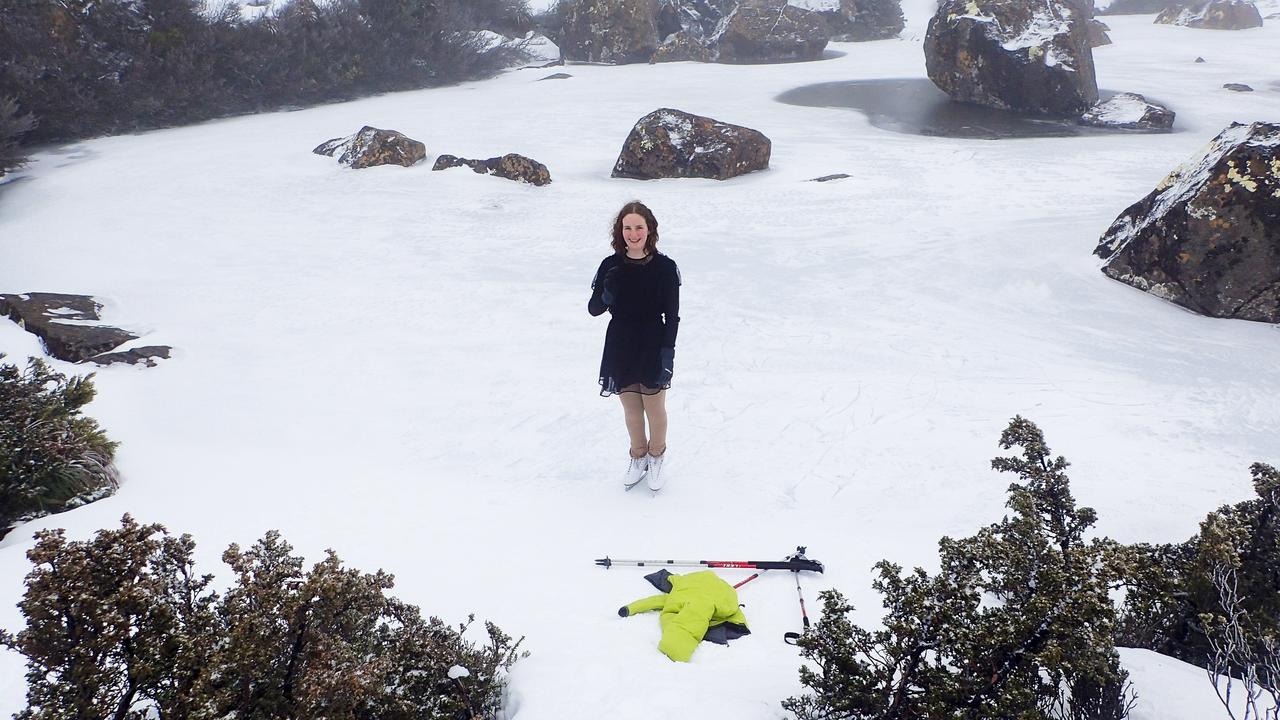 Ellie Woodward skating on the first tarn, Tarn Shelf, Mt Field, Tasmania, 4 Aug 2019. Courtesy Brett Woodward.
Ellie Woodward skating on the first tarn, Tarn Shelf, Mt Field, Tasmania, 4 Aug 2019. Courtesy Brett Woodward.

